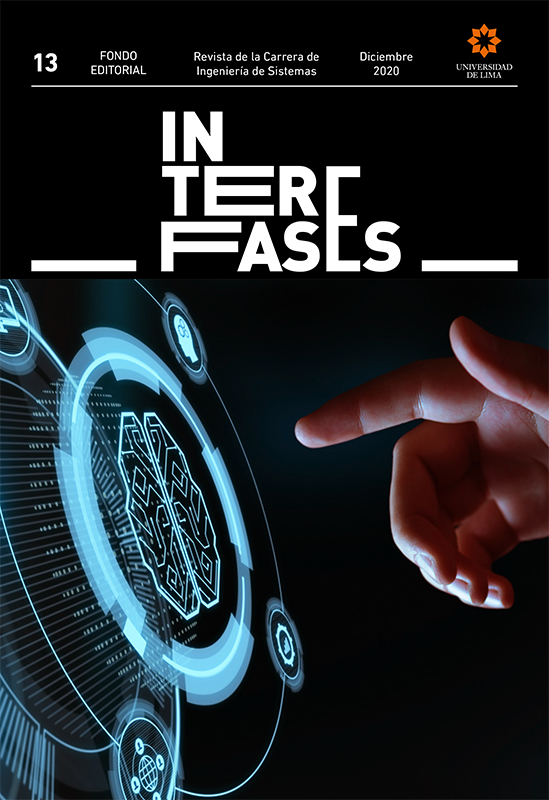Software in the Loop for the implementation of an autopilot system for fixed-wing aircrafts
DOI:
https://doi.org/10.26439/interfases2020.n013.4857Keywords:
SITL, autopilot, aircrafts, Software Engineering, Simulink, PIDAbstract
When you want to develop and test software products for complex systems such as airplanes, space shuttles, satellites, automobiles or nuclear plants, one of the biggest drawbacks is the availability of the physical system, due to the great complexity, risks and costs involved in performing tests on the real system. Software in the Loop (SITL) allows us to test algorithms, source code or control strategies for complex systems within a simulation that contains the mathematical model of the real physical system. This research work proposes the use of a Software in the Loop platform for the development of an autopilot system for a fixed-wing aircraft. The architecture of the implemented application, the software design process, the protocols used, the control strategies, the programming techniques, the results obtained and the conclusions are shown herein.
Downloads
References
Aboelela, M. A. S., Ahmed, M. F., y Dorrah, H. T. (2012). Design of aerospace control systems using fractional PID controller. Journal of Advanced Research, 3(3), 225–232. http://doi.org/10.1016/j.jare.2011.07.003
Akyürek, Ş., Kürkçü, B., Kaynak, Ü., y Kasnakoğlu, C. (2016). Control Loss Recovery Autopilot Design for Fixed-Wing Aircraft. IFAC-PapersOnLine, 49(9), 117-123. http://doi.org/10.1016/j.ifacol.2016.07.509
Astrom, K. J. (2002). PID Control. Control System Design, 216–251. Recuperado de https://www.cds.caltech.edu/~murray/courses/cds101/fa02/caltech/astrom-ch6.pdf
Attya, S. M., y Abdulla, A. I. (2018). PID Controller Design and Simulation for Aircraft Roll Control Based on Evolutionary Technique Using MATLAB, JET, 8(3), 5-9. Recuperado de http://doi.org/10.17605/OSF.IO/UT8FB
Bansal, H. O. (2009). Tuning of PID Controllers using Simulink. International Journal of Mathematical Modeling, Simulations and Applications, 2(3), 337–344. Recuperado de https://www.researchgate.net/publication/268802558_Tuning_of_PID_Controllers_using_Simulink
Coopmans, C., Podhradský, M., y Hoffer, N. V. (2016). Software- and hardware-in-the-loop verification of flight dynamics model and flight control simulation of a fixed-wing unmanned aerial vehicle. 2015 Workshop on Research, Education and Development of Unmanned Aerial Systems, RED-UAS 2015, 115-122. http://doi.org/10.1109/RED-UAS.2015.7440998
Cova, W. J. D. (2005). Control PID, un Enfoque Descriptivo. Universidad Tecnológica Nacional, Facultad Regional La Rioja, Departamento de Electrónica. Recuperado de http://www.frlr.utn.edu.ar/archivos/alumnos/electronica/catedras/38-sistemas-decontrol-aplicado/Publicaciones/Control_PID_Enfoque_Descriptivo.pdf
De Castro, D. F., y dos Santos, D. A. (2016). A software-in-the-loop simulation scheme for position formation flight of multicopters. Journal of Aerospace Technology and Management, 8(4), 431–440. http://doi.org/10.5028/jatm.v8i4.612
Ellingsen, G., y McLain, T. (2017). ROSplane: Fixed-wing autopilot for education and research. 2017 International Conference on Unmanned Aircraft Systems, ICUAS 2017, 1503–1507. http://doi.org/10.1109/ICUAS.2017.7991397
FlightGear. (2020). FlightGEar Flight Simulator. Recuperado de https://www.flightgear.org/
Gouthami, E., y Rani, M. A. (2016). Modeling of an Adaptive Controller for an Aircraft Roll Control System using PID, Fuzzy-PID and Genetic Algorithm, 11(1), 15-24. http://doi.org/10.9790/2834-11121524
Hartanto, S., Furqan, M., Putera, A., Siahaan, U., y Fitriani, W. (2017). Haversine Method in Looking for the Nearest Masjid. International Journal of Engineering Research, (agosto). http://doi.org/10.23883/IJRTER.2017.3402.PD61H
Islam, M. T., Alam, M. S., Laskar, M. A. R., y Garg, A. (2016). Modeling and simulation of longitudinal autopilot for general aviation aircraft. 2016 5th International Conference on Informatics, Electronics and Vision, ICIEV 2016, (diciembre del 2017), 490–495. http://doi.org/10.1109/ICIEV.2016.7760051
Jia, Y.-B. (2020). Rotation in the Space. Iowa State University, 1-14. Recuperado de http://web.cs.iastate.edu/~cs577/handouts/rotation.pdf
Khalid, A., Zeb, K., y Haider, A. (2019). Conventional PID, adaptive PID, and sliding mode controllers design for aircraft pitch control. 2019 International Conference on Engineering and Emerging Technologies, ICEET 2019, (julio), 1-6. http://doi.org/10.1109/CEET1.2019.8711871
Koks, D. (2008). Using Rotations to Build Aerospace Coordinate Systems. Electronic Warfare and Radar Division Systems Sciences Laboratory. Recuperado de https://apps.dtic.mil/dtic/tr/fulltext/u2/a484864.pdf
Korkmaz, H., Ertin, O. B., Kasnakoǧlu, C., y Kaynak, Ü. (2013). Design of a Flight Stabilizer System for a Small Fixed Wing Unmanned Aerial Vehicle using System Identification. IFAC Proceedings Volumes (IFAC-PapersOnline), 1(PART 1), 145-149. http://doi.org/10.3182/20130916-2-tr-4042.00012
Peet, M. M. (2010). Spacecraft and Aircraft Dynamics. Illinois Institute of Technology. Recuperado de http://control.asu.edu/Classes/MMAE441/Aircraft/441Lecture1.pdf
Qays, H. M., Jumaa, B. A., y Salman, A. D. (2019). Design and Implementation of Autonomous Quadcopter using SITL Simulator. Iraqi Journals of Computers, Communications, Control & Systems Engineering, 20(1), 1-16. http://doi.org/10.33103/uot.ijccce.20.1.1
R., R., M., C., S., C., Kumar, P., y N., P. (2020). PID Controller Design for Dynamic Motion of an Aircraft. SSRN Electronic Journal, (mayo), 859-862. http://doi.org/10.2139/ssrn.3511417
Redshift Labs. (2020). Understanding Euler Angles. Chrobotics. Recuperado de http://www.chrobotics.com/library/understanding-euler-angles
Slabaugh, G. G. (2017). Computing Euler Angles from a Rotation Matrix. Digital Environment Research Institute (DERI) Queen Mary University of London, 1-7. Recuperado de https://www.gregslabaugh.net/publications/euler.pdf
Sudha, G., y Deepa, S. N. (2016). Optimization for PID Control Parameters on Pitch Control of Aircraft Dynamics Based on Tuning Methods. Applied Mathematics and Information Sciences, 10(1), 343-350. http://doi.org/10.18576/amis/100136
Surowski, D. (2011). Distance between Points on the Earth’s Surface. Kansas State University, Department of Mathematics. Recuperado de https://www.math.ksu.edu/~dbski/writings/haversine.pdf
Wahid, N., Hassan, N., Rahmat, M. F., & Mansor, S. (2011). Application of Intelligent Controller in Feedback Control Loop for Aircraft Pitch Control. Australian Journal of Basic and Applied Sciences, 5(12), 1065–1074. Recuperado de http://www.ajbasweb.com/old/ajbas/2011/December-2011/1065-1074.pdf
White, M. (2019). PID Control for Robotics. Programming. Recuperado de https://mjwhite8119.github.io/Robots/pid-control
Downloads
Published
Issue
Section
License
Authors who publish with this journal agree to the following terms:
Authors retain copyright and grant the journal right of first publication with the work simultaneously licensed under an Attribution 4.0 International (CC BY 4.0) License. that allows others to share the work with an acknowledgement of the work's authorship and initial publication in this journal.
Authors are able to enter into separate, additional contractual arrangements for the non-exclusive distribution of the journal's published version of the work (e.g., post it to an institutional repository or publish it in a book), with an acknowledgement of its initial publication in this journal.
Authors are permitted and encouraged to post their work online (e.g., in institutional repositories or on their website) prior to and during the submission process, as it can lead to productive exchanges, as well as earlier and greater citation of published work (See The Effect of Open Access).
Last updated 03/05/21


